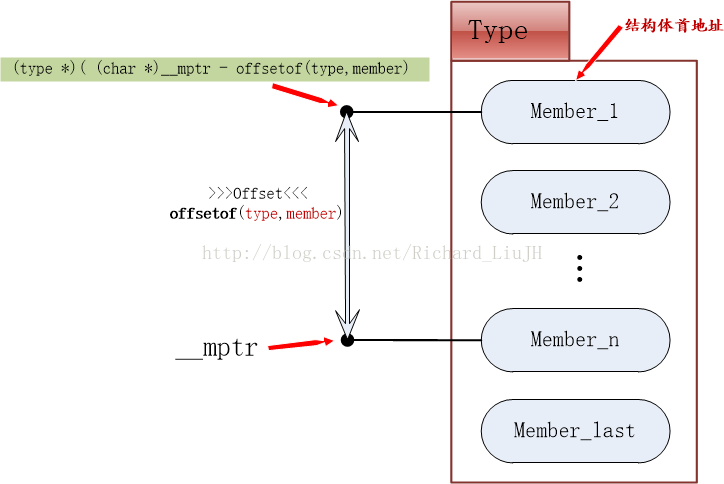比较:
1.list_for_each和list_for_each_entry都是遍历链表的两个宏,本质上都是for循环。
2.他们做的事情本质上都一样,A.获取链表头,B.判断链表项是不是链表头,C.指向链表的下一项。
3.他们的区别:list_for_each遍历的链表,其链表项不属于某个结构体。或者说不关心它是不是包含在某个结构体中。
list_for_each_entry遍历的链表,其每一项都是某个结构体中的成员,单纯遍历链表还不行,还要找到包含这个
链表项的结构体的地址,从而为下一步应用该结构体做好准备。
一、list_for_each
list_for_each内核中的定义: /** * list_for_each - iterate over a list * @pos: the &struct list_head to use as a loop cursor. * @head: the head for your list. */ #define list_for_each(pos, head) for (pos = (head)->next; pos != (head); pos = pos->next)
一个简单的for循环。
循环的初始化工作:pos指向链表头的下一项。
循环的条件:pos不是链表头。
每次循环要做的事情:pos指向链表中的下一项
二、list_for_each_entry
/** * container_of - cast a member of a structure out to the containing structure * @ptr: the pointer to the member. * @type: the type of the container struct this is embedded in. * @member: the name of the member within the struct. * */ #define offsetof(TYPE, MEMBER) ((size_t) &((TYPE *)0)->MEMBER) #define container_of(ptr, type, member) ({ const typeof(((type *)0)->member)*__mptr = (ptr); (type *)((char *)__mptr - offsetof(type, member)); }) /** * list_entry - get the struct for this entry * @ptr: the &struct list_head pointer. * @type: the type of the struct this is embedded in. * @member: the name of the list_struct within the struct. */ #define list_entry(ptr, type, member) container_of(ptr, type, member) /** * list_for_each_entry - iterate over list of given type * @pos: the type * to use as a loop cursor. * @head: the head for your list. * @member: the name of the list_struct within the struct. */ #define list_for_each_entry(pos, head, member) for (pos = list_entry((head)->next, typeof(*pos), member); &pos->member != (head); pos = list_entry(pos->member.next, typeof(*pos), member))
将for循环分解为一下三点:
1. for循环初始化 pos = list_entry((head)->next, typeof(*pos), member);
2. for循环执行条件 &pos->member != (head);
3. 每循环一次执行 pos = list_entry(pos->member.next, typeof(*pos), member))
解析:
1、(type *)0是一个强转的操作,将0强行装换成type类型的指针。
type类型是container_of的第二个参数,所以在使用container_of时第二个参数应该传类型。
2、pos = list_entry((head)->next, typeof(*pos), member) , list_entry ---> container_of,因为list_entry第二个参数是typeof(* pos)。
typeof()是取变量的类型,这里是取指针pos所指向数据的类型
3、(type *)0)->member的作用就是得到成员变量member后,再通过typeof((type *)0)->member),就知道member成员的类型。
4、offsetof(type,member)是求出member在结构体中的偏移量,其中type是结构体的类型。
(char *)__mptr - offsetof(type,member)就是 __mptr - offset,即member类型的指针减去member在结构体中的偏移量。
一般__mptr = ptr,ptr是member的地址,那么member的地址减去member在结构体中偏移量不就是得到结构体的地址。
5、container_of的作用很明显了 -- 获得结构体的地址。
那么我们需要给他提供三个参数,分别是:ptr:member成员的指针 type:结构体类型 member:成员member的名字。

结构体pos中包含链表member,遍历pos中的member成员。
pos: pos:
___________ ____________
| | | |
| | | |
| ........... | | ................ |
| | | |
| | | |
| member: | _________|__> member |
| { | | | { |
| *prev; | | | *prev; |
| *next;--|---------- | *next;-------------
| } | | } | |
|—^———— | |____________| |
| |
| |
|_____________________________________________|